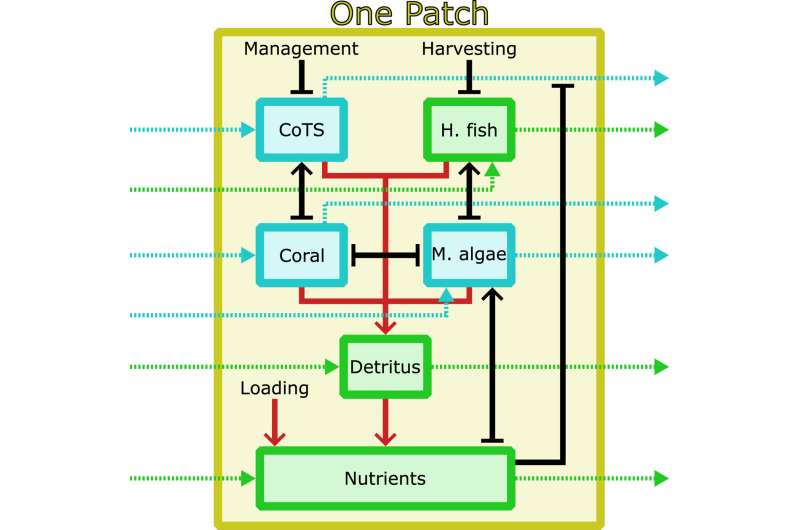This article has been reviewed according to Science X's editorial process and policies. Editors have highlighted the following attributes while ensuring the content's credibility:
fact-checked
trusted source
proofread
Using mathematical modeling to save coral reefs

A team of researchers at the University of Waterloo is using mathematical models to help determine the best strategies for saving coral reefs from climate change.
As havens of biodiversity, coral reefs are some of the world's most important ecosystems—and some of the most vulnerable to the impacts of climate change. While the world's reefs face numerous intersecting threats, the Waterloo team focused on predicting outbreaks of crown-of-thorns (CoT) starfish.
"They are covered in toxic spikes, so they don't have a lot of natural predators," said Russell Milne, a recent Ph.D. graduate in applied mathematics and the study's corresponding author. "They also reproduce by dispersing their larvae into the open water—so if you have a starfish outbreak in one area, the entire reef will be affected."
CoT starfish are invertebrates that eat coral at an alarming rate. A large outbreak can destroy a coral reef in as little as a month. Scientists have noticed that CoT outbreaks have dramatically increased over the last thirty years due to industrial development and warming ocean temperatures.
One of the biggest factors in CoT starfish outbreaks is nutrient loading—increased sewage and industrial run-off in oceans that, in turn, lead to bumper crops of the microorganisms that CoT larvae feast on. Another factor affecting outbreaks is overfishing. If there are fewer herbivorous fish around, the fast-growing aquatic plants that these fish eat can expand into areas that coral occupied prior to an outbreak. This makes it harder for the coral to grow back.
Most CoT starfish research, however, has focused on Australia's Great Barrier Reef. Milne's team was interested in predicting how CoT outbreaks might affect other important reefs in areas of the world with differing resources and priorities.
They focused on reefs adjacent to two rapidly growing cities: Cebu City, Philippines, and Jeddah, Saudi Arabia. Then, they built a mathematical model called a metacommunity model, which incorporates population levels of different species at many locations on a reef. They used this model to simulate how increased fishing pressure and nutrient loading in those areas might trigger CoT starfish outbreaks.
Their model also helped them predict what impact specific interventions—such as limiting run-off or manually removing starfish from portions of the reef—would have on overall reef health.
"This research demonstrates the importance of long-term planning for reef management," Milne said. "As we fight climate change, we have to think about how environmental stressors interact in unexpected ways."
The study, "Preparing for and managing crown-of-thorns starfish outbreaks on reefs under threat from interacting anthropogenic stressors," was published in the journal Ecological Modelling.
More information: Russell Milne et al, Preparing for and managing crown-of-thorns starfish outbreaks on reefs under threat from interacting anthropogenic stressors, Ecological Modelling (2023). DOI: 10.1016/j.ecolmodel.2023.110443
Provided by University of Waterloo

















